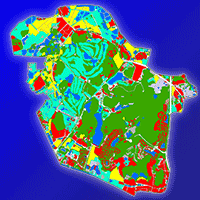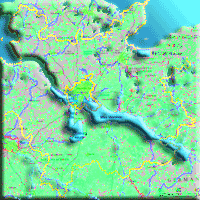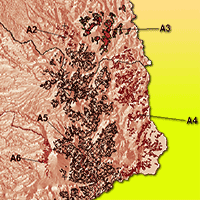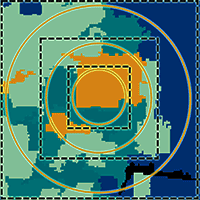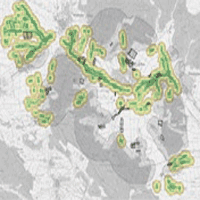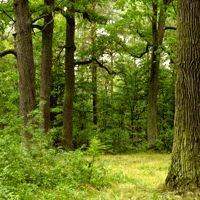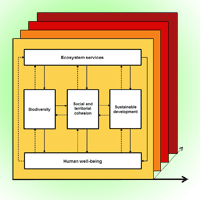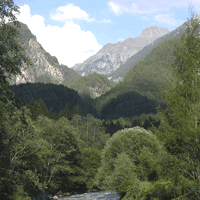Urban forests are important as they provide recreation areas and offer ecological services. Both functions determine the status of an urban forest and reflect contradictory aspects of forest tourism development and environment conservation. However, assessment of urban forest health status at a landscape scale remains scarce. Here, we selected the Nanguo Peach Garden, China, as the study area. Urban forest health status at the landscape scale were classified into recreation and eco-conservation services. Sustainability was quantified using the principal component analysis and the Kriging method to map the landscape classification in the study area. With regard to landscape recreation sustainability, some 18.9% of the total study region was classified as “very good”. They were mainly distributed in the north, southwest, and southeast parts of the study area. The central and southeast regions, accounting for 9.5% of the total area, were classified as “very good” for eco-conservation sustainability. Regarding landscape health, the region classified as “very good” accounted for 11.1% of the total study area, and it was mainly distributed in the southern part of the area; the region classified as “very poor” accounted for 16.4% of the total area, and it was located in the northwestern and eastern parts of the study area. With improved landscape health status, the forest/non-forest patch area ratio was increased and the patch number ratio was decreased. A landscape was considered the healthiest when the forest/ non-forest area ratio was 0.65 and the patch number was 0.48. The spatial distribution of landscape recreation sustainability and eco-conservation sustainability differed in the Nanguo Peach Garden, and a close relationship was observed between the landscape health and forest landscape internal structure. Forest/non-forest patch area ratios and patch number ratios were relatively stable and constant, suggesting the urban forest landscapes were healthy. The healthiest forest landscapes were mainly distributed in the forest/non-forest transition zone and the unhealthiest forest landscape was mainly located in a single natural forest.
Keywords
, , , ,
Citation
Zhao Q, Tang H-H, Gao C-J, Wei Y-H (2020). Evaluation of urban forest landscape health: a case study of the Nanguo Peach Garden, China. iForest 13: 175-184. - doi: 10.3832/ifor3206-013
Academic Editor
Raffaele Lafortezza
Paper history
Received: Jul 31, 2019
Accepted: Feb 13, 2020
First online: May 02, 2020
Publication Date: Jun 30, 2020
Publication Time: 2.63 months
© SISEF - The Italian Society of Silviculture and Forest Ecology 2020
Open Access
This article is distributed under the terms of the Creative Commons Attribution-Non Commercial 4.0 International (https://creativecommons.org/licenses/by-nc/4.0/), which permits unrestricted use, distribution, and reproduction in any medium, provided you give appropriate credit to the original author(s) and the source, provide a link to the Creative Commons license, and indicate if changes were made.

Breakdown by View Type
(Waiting for server response...)
Article Usage
Total Article Views: 42796
(from publication date up to now)
Breakdown by View Type
HTML Page Views: 34981
Abstract Page Views: 3909
PDF Downloads: 3123
Citation/Reference Downloads: 0
XML Downloads: 783
Web Metrics
Days since publication: 2052
Overall contacts: 42796
Avg. contacts per week: 145.99
Article Citations
Article citations are based on data periodically collected from the Clarivate Web of Science web site
(last update: Mar 2025)
Total number of cites (since 2020): 5
Average cites per year: 0.83
Publication Metrics
by Dimensions ©
Articles citing this article
List of the papers citing this article based on CrossRef Cited-by.
(1)
Bradley GA (1984)The urban/forest interface. In: “Land Use and Forest Resources in a Changinq Environment: The Urban Forest Interface” (Bradley GA ed). University of Washington Press, Seattle, WA, USA, pp. 3-16.
Online |
Gscholar
(2)
Breuste JH (2004)Decision making, planning and design for the conservation of indigenous vegetation within urban development. Landscape and urban Planning 68 (4): 439-452.
CrossRef |
Gscholar
(3)
Cao Y, Khasbagan Song DM (2002)A review on the concept, characteristic and assessment of landscape health. Chinese Journal of Applied Ecology 13 (11): 1511-1515.
Online |
Gscholar
(4)
Chen G, Deng HB, Wang QL, Dai LM, Hao ZQ (2003)Approaches for assessing forest ecosystem health. Chinese Journal of Applied Ecology 14 (6): 995-999.
Online |
Gscholar
(5)
Chen LD, Fu BJ, Wang J (2001)Study on land use change in a small typical catchment in loess hilly area - a case study in Danangou Catchment, Yan’an, Shaanxi Province. Scientia Geographica Sinica 21 (1): 46-51.
Gscholar
(6)
Chen WY, Jim CY (2010)Resident motivations and willingness-to-pay for urban biodiversity conservation in Guangzhou (China). Environmental Management 45 (5): 1052-1064.
CrossRef |
Gscholar
(7)
Clark JR, Matheny NP, Cross G, Wake V (1997)A model of urban forest sustainability. Journal of Arboriculture 23: 17-30.
Gscholar
(8)
Cumming AB, Galvin MF, Rabaglia RJ, Cumming JR, Twardus DB (2001)Forest health monitoring protocol applied to roadside trees in Maryland. Journal of Arboriculture 27 (3): 126-138.
Online |
Gscholar
(9)
Drever MC, Aitken KEH, Norris AR, Martin K (2008)Woodpeckers as reliable indicators of bird richness, forest health and harvest. Biological Conservation 141 (3): 624-634.
CrossRef |
Gscholar
(10)
Dwyer JF, Nowak DJ (2003)Sustaining urban forests. Journal of Arboriculture 29 (1): 49-55.
Gscholar
(11)
McPherson EG (1998)Structure and sustainability of Sacramento’s urban forest. Journal of Arboriculture 24: 174-190.
Online |
Gscholar
(12)
Feng JG, Wang JS, Yao SC, Ding L (2016)Dynamic assessment of forest resources quality at the provincial level using AHP and cluster analysis. Biological Conservation 124 (2016): 184-193.
CrossRef |
Gscholar
(13)
Frondoni R, Mollo B, Capotorti G (2011)A landscape analysis of land cover change in the Municipality of Rome (Italy): spatio-temporal characteristics and ecological implications of land cover transitions from 1954 to 2001. Landscape and Urban Planning 100 (1-2): 117-128.
CrossRef |
Gscholar
(14)
Godefroid S, Koedam N (2003)How important are large
vs. small forest remnants for the conservation of the woodland flora in an urban context? Global Ecology and Biogeography 12 (4): 287-298.
CrossRef |
Gscholar
(15)
Gong P, Zhang LS, Gu XR (2016)Influences of prototype landscape on people’s perceptions of urban plant landscape. Scientia Silvae Sinicae 52 (9): 67-76.
Online |
Gscholar
(16)
Gundersen V, Köhler B, Myrvold KM (2019)Seeing the forest for the trees: a review-based framework for better harmonization of timber production, biodiversity, and recreation in boreal urban forests. Urban Science 3 (4): 113.
CrossRef |
Gscholar
(17)
Hagget P, Cliff AD, Fry A (1977)Locational analysis in human geography. Edward Arnold, London, UK, pp. 605.
Gscholar
(18)
Jestaedt M (2008)Experiences in the management of urban recreational forests in Germany. In: “Ecology, Planning, and Management of Urban Forests” (Carreiro MM, Song YC, Wu JG eds). Springer, New York, USA, pp. 301-311.
CrossRef |
Gscholar
(19)
Johnston D, Lowell K (2000)Forest volume relative to cartographic boundaries and sample spacing, unit size and type. Geographical and Environmental Modelling 4 (1): 105-120.
CrossRef |
Gscholar
(20)
Kolb TE, Wagner MR, Covington WW (1994)Concepts of forest health: utilitarian and ecosystem perspectives. Journal of Forestry 92 (7): 10-15.
Online |
Gscholar
(21)
Lausch A, Erasmi S, King D, Magdon P, Marco H (2017)Understanding forest health with remote sensing-part II-a review of approahes and data models. Remote Sensing 9 (2): 129.
CrossRef |
Gscholar
(22)
Li BQ, Wu CC, Wu ZW (2009)The development roadmap analysis on China’s Forest Parks. Acta Ecologica Sinica 29 (5): 2749-2756.
Gscholar
(23)
Li T, Cui YH, Liu AG (2017)Spatiotemporal dynamic analysis of forest ecosystem services using “big data”: a case study of Anhui province, central-eastern China. Journal of Cleaner Production 142 (2): 589-599.
CrossRef |
Gscholar
(24)
Li W, Wang C, Jia BQ, Qie GF (2008)Research progress on urban forest pattern optimization. World Forestry Research 21 (2): 16-21.
Gscholar
(25)
Li YF, Liu HY, Zhang HB, Sun Li YM YL (2015)The study of landscape health based on landscape structure and water environment: a case study of Xixi Wetland Park in Hangzhou. Journal of Natural Resources 30 (5): 761-771.
Gscholar
(26)
Li YF, Liu HY, Zheng N, Cao X (2011)A functional classification method for examining landscape pattern of urban wetland park: a case study on Xixi Wetland Park, China. Acta Ecologica Sinica 31 (4): 1021-1028.
CrossRef |
Gscholar
(27)
Li YF, Liu HY, Cao X, Zheng N (2010)Spatial differences of landscape health in urban wetland parks: a case study of Xixi Wetland Park in Hangzhou. Acta Geographica Sinica 65 (11): 1429-1437.
Gscholar
(28)
Liu GY, Yang ZF, Chen B, Zhang Y, Zhang L (2008)Energy-based urban ecosystem health assessment: a case study of Baotou City. Acta Ecologica Sinica 28 (4): 1720-1728.
Gscholar
(29)
Luo F, Bao JG (2013)Evolutional process and characteristics of national forest parks in China: a perspective of the logic of state, market and society. Economic Geography 33 (3): 164-169.
Online |
Gscholar
(30)
Masek JG, Hayes GJ, Hughes MJ, Healey SP, Turner DP (2015)The role of remote sensing in process-scaling studies of managed forest ecosystems. Forest Ecology and Management 355: 109-123.
CrossRef |
Gscholar
(31)
McPherson EG, Xiao QF, Van Doorn NS, Goede JD, Bjorkman J, Hollander A, Boynton RM, Quinn JF, Thorne JH (2017)The structure, function and value of urban forests in California communities. Urban Forestry and Urban Greening 28: 43-53.
CrossRef |
Gscholar
(32)
Nováková J (2008)Vegetation changes in Prague’s suburban forest during the last 40 years - human impact and legislative protection. Urban Forestry and Urban Greening 7 (4): 301-314.
CrossRef |
Gscholar
(33)
Nowak DJ, Dwyer JF (2000)Understanding the benefits and costs of urban forest ecosystems. Springer, New York, USA, pp. 25-46.
Gscholar
(34)
Tang SZ, Lei XD (2014)Achieving win-win situation in forest conservation and timber supply through enhanced forest management. Scientia Sinica Vitae 44 (3): 223-229.
CrossRef |
Gscholar
(35)
Piccolo BP, Deelen TR, Hollis-Etter HE, Etter DR, Warner RE, Anchor C (2010)Behavior and survival of white-tailed deer neonates in two suburban forest preserves. Canadian Journal of Zoology 88 (5): 487-495.
CrossRef |
Gscholar
(36)
Pirnat J, Randrup TB, Konijnendijk CC (2000)Conservation and management of forest patches and corridors in suburban landscapes. Landscape and Urban Planning 52 (2-3): 135-143.
CrossRef |
Gscholar
(37)
Ren ZB, Zheng HF, He XY, Zhang D, Yu XY, Shen GQ (2015)Spatial estimation of urban forest structures with Landsat TM data and field measurements. Urban Forestry and Urban Greening 14 (2): 336-344.
CrossRef |
Gscholar
(38)
Roongtawanreongsri S, Sawangchote P, Bumrungsri S, Suksroj C (2015)Economic benefit of management options for a suburban forest (Kho Hong Hill) in South Thailand. Springer Singapore, Singapore City, pp. 275-297.
CrossRef |
Gscholar
(39)
Styers DM, Chappelka AH, Marzen LJ, Somers GL (2010)Developing a land-cover classification to select indicators of forest ecosystem health in a rapidly urbanizing landscape. Landscape and Urban Planning 94 (3-4): 158-165.
CrossRef |
Gscholar
(40)
Van Herzele A, Wiedemann T (2003)A monitoring tool for the provision of accessible and attractive urban green spaces. Landscape and Urban Planning 63 (2): 109-126.
CrossRef |
Gscholar
(41)
Woodall CW, Grambsch PL, Thomas W, Moser WK (2005)Survival analysis for a large-scale forest health issue: Missouri oak decline. Environmental Monitoring and Assessment 108 (1): 295-307.
CrossRef |
Gscholar
(42)
Wu JG (2000)Landscape ecology: pattern, process, structure and scale. Higher Education Press, Beijing, China, 99-109.
Gscholar
(43)
Yang J, Zhao L, Mcbride J, Gong P (2009)Can you see green? Assessing the visibility of urban forests in cities. Landscape and Urban Planning 91 (2): 97-104.
CrossRef |
Gscholar
(44)
Yu YJ, Guo HC, LiuY, Jiang YM, Li YQ, Huang K (2008)Syndromic city illnesses diagnosis and urban ecosystem health assessment. Acta Ecologica Sinica 28 (4): 1736-1747.
Gscholar
(45)
Zhao Q, Zheng G, Huang Q (2007)Characteristics of urban forest landscape pattern and optimization of urban forest spatial structure: A case study of Nanjing city. Acta Geographica Sinica 62 (8): 870-878.
Online |
Gscholar
(46)
Zirlewagen D, Raben G, Weise M (2007)Zoning of forest health conditions based on a set of soil, topographic and vegetation parameters. Forest Ecology and Management 248 (1-2): 43-55.
CrossRef |
Gscholar
